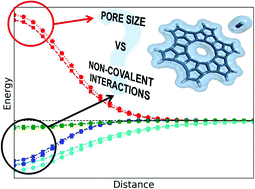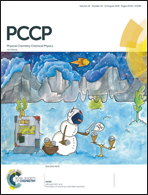On the importance of non-covalent interactions for porous membranes: unraveling the role of pore size†
Abstract
Membrane-based gas separation technology is of crucial importance in the current economy and nanoporous graphene, given its single-atomic layer, is an essential building-block material to achieve efficiency towards permeability and selectivity for such processes. Classically, pore size is the main feature that governs the diffusion energy barrier. Its nature, nevertheless, is also affected by other non-negligible physical mechanisms not yet discussed. Here we propose a theoretical study on the role of non-covalent interactions towards H2 diffusion through two graphene-based membranes. Symmetry-Adapted Perturbation Theory (SAPT) was used to investigate the total interaction energy and its physically meaningful components (electrostatics, exchange, induction and dispersion). The study reveals the importance of quantum effects such as polarization and electron delocalization in order to counterbalance the abiding idea of pore size being the dominant factor accounting for the energy barrier. These results have important implications for the rational design of efficient nanoporous devices for separation applications.



 Please wait while we load your content...
Please wait while we load your content...